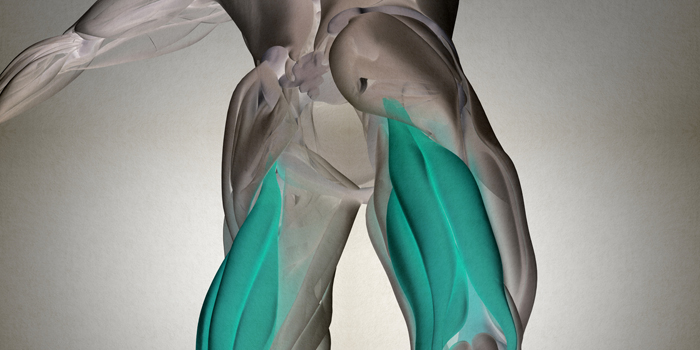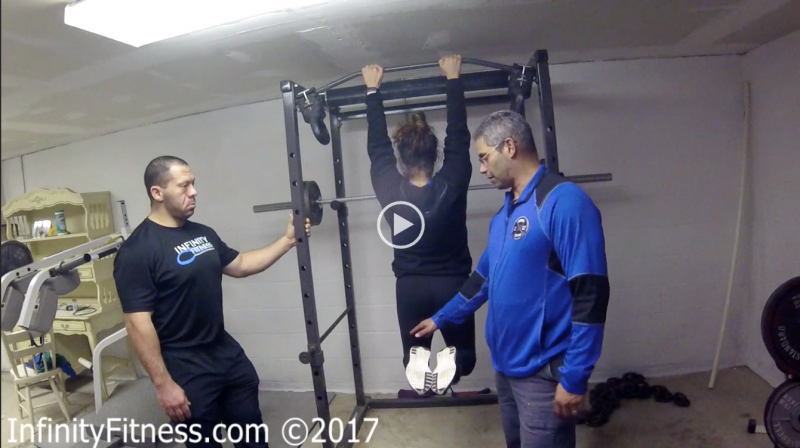
Coauthored by Scott H. Mendelson and Eric Serrano, MD
Over the years many elite athletes, including NFL players, have sought Dr. Serrano’s help with correcting chronic hamstring dysfunction. In addition to accomplishing that goal, this unique drill also allows for examination of the connection between the lats, hips, and hamstrings.
Surprisingly, many NFL athletes initially score very poorly on this simple test, revealing the depth of their problems. Dr. Serrano has used this test and the resulting exercise variations to improve hamstring power and to prevent many common injuries such as pulls during competition. An excellent first-stage hamstring exercise and evaluation tool is the hamstring praying contraction.
The hanging position must be performed with scapular retraction to protect the shoulders. Larger athletes such as football linemen may need special modifications if they are lacking in grip strength to hold the contracted position for 15-30 seconds. Try starting with three sets of 15 seconds per set, using perfect form. Progress by adding five seconds every other week to reach 30 seconds.
Watch Dr. Serrano demonstrate how to properly perform the hanging hamstring raise.
Advanced Variations: Chains and Bands
Dr. Serrano has developed many advanced variations for this exercise using chains, bands, and other tools to add strategic challenge. The objective is not to overload the hamstrings, and a gradual approach must be taken to prevent injury. Advanced variations are not needed until an athlete can complete three sets of thirty-second holds with ninety-degree knee flexion without cramping.
Knees Together
Keeping the knees together allows for a more accurate evaluation of the hamstrings. Spreading the knees out has more of a glute emphasis and can be used for other purposes. The hanging position can also be used to stretch the psoas muscle, which is commonly very tight among athletes. Maintaining plantar flexion with the feet throughout the set is very important.
Unilateral Evaluations
In many cases, an athlete will have more range of motion with one leg than the other, which can reveal an injury waiting to happen. While the hanging hamstring raise can be used to balance strength between both legs, there may be other underlying weaknesses that must be addressed with additional specialized movements. The runner stance hanging position is very challenging and can be used to fix strength deficits.
Building the Hanging Hamstring Raise into the Training Program
Following a warm-up to break a sweat and then general activation drills, the hanging hamstring raise should be performed at the start of a lower-body training routine. The unique stimuli provided by this movement creates a better response when the muscles and nervous system are fresh at the start of a training session.
Frequency of Use
This special hamstring movement can be done once or twice per week, pending the recovery capabilities of the athlete. Initially once per week will likely be adequate, and as the challenges become more familiar, a second session may be needed. Trainees should be fully recovered between hanging hamstring sessions, judged by the lack of muscle soreness and nervous system readiness.
Improve Entire Training Session Execution
Executing the hanging hamstring raise movement at the beginning of a training session serves to activate the posterior chain, which can result in improved performance during squats, deadlifts, Olympic movements, and other exercises. Poor recruitment of the hamstrings, hips, and other muscles are factors limiting the success of athletes ranging from youth to professional.
Scott H. Mendelson, director of www.InfinityFitness.com, is a highly regarded performance nutrition and training specialist. In addition to designing customized programs for his celebrity, weekend warrior and executive clients, Scott works daily with professional athletes from the NFL, NHL, MLB, NBA and NCAA. Scott has built an excellent reputation providing effective supplements, cutting-edge information and unmatched service to thousands of clients worldwide since 1999.
Scott@infinityfitness.com Special assistant to Dr. Eric Serrano MD, Scott helps with the design of training, nutrition and supplementation trials to confirm the effectiveness of protocols and expand his expertise.
Dr. Eric Serrano, MD, is the ace sought out by elite athletes and business professionals around the world for help with the most difficult of problems. Dr. Serrano spends a majority of his time promoting the success of his family practice patients in Pickerington; a suburb of Columbus Ohio. Amongst the thousands of patients are elite athletes from around the globe who will travel to the ends of the earth to consult with Dr. Serrano.










